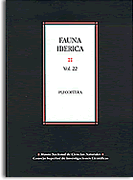|
|
|
Publications
'Fauna Ibérica' Series
|
 |
Volume 0 -Coleoptera, Ptinidae, Gibbiinae
Author(s):
Xavier Bellés
Forward:
Edward O. Wilson
Preface:
María
Angeles Ramos
ISBN:
Madrid 2003. 440pp.84-00-08198-6
|
Forward
by Edward O. Wilson, Harvard University (December, 1989)
During the 1980s the world witnessed and awakening to the
great problems facing the enviroment, and ecology attained
new prominence as a scientific discipline. Against this background,
a second and more surprising development ocurred: recognition
of the biodiversity crisis. Everywhere evidence has come
to light that the degradations of habitats, through pollution
and outright removal, is causing the destruction of large
numbers of species. It seems problable that unless corrective
measures are taken, as many as one-quarter of all species
of the world biota will disappear by the year 2050. And many
of the species that do survive will lose some of their genetic
variability. Bilogists who study biodiversity agree that
the extinction spasm now occurring is the most severe since
the end of the Mesozoic Era 65 millions years ago.
The biodiversity crisis gives special urgency to the Iberian
Fauna project, in recognition that something very ancient
and precious is being lost. Each country can be said to have
three kinds of wealth: material, cultural, and biological.
We trend to think of the first two as all that matters in
our lives. But biological wealth is also extremely important.
The fauna and flora are essential to enviromental balance
and smooth cycling of water, minerals and nutrients. The
native animal and plant species, specially that found nowhere
else, must be regarded as part of the national heritage of
each country. They offer us priceless economic and aesthetic
benefits.
It is a common misconception that the classification of
organism, of the kind exemplified by the Iberian Fauna, is
an old fashioned, nearly completed discipline. Nothing could
be further from the thruth. At the present time about 1.4
million species of animals, plants and microorganisms are
known to science, that is, have been given formal scientific
names. But the actual number is not known to the nearest
order of magnitude. Estimates range according to method of
analysis and author from 5 to 30 million. Even the European
and North American biotas are still imperfectly known. New
species are discovered on the Iberian Peninsula each year.
Apart from the first step of discovery, vast amounts of research
are needed to delinate the distributions,origins, and relationships
of the knonw species. It should furthermore be kept in mind
that basic ecology and the practice of enviromental management
depend on a sound taxonomic knowledge of local biotas.
The Iberian Fauna series can be expected not only to illuminate
the Iberian biota more fully than ever before but to set
the stage for an expanding array of ecological and other
biological studies in the future. It is as much a part of
modern science, and as important for humanity, as studies
in participle physics and molecular biology.
versión
española
|
|
|

